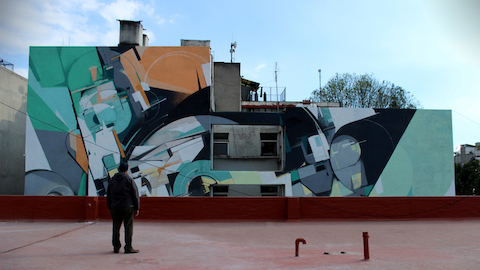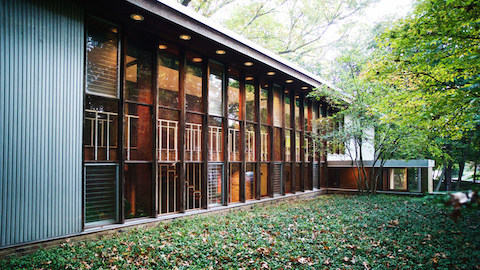Browse any Mexico City travel guide and you will invariably find the words “bohemian,” “artsy,” or “eclectic” attributed to the southwestern boroughs of Condesa and Roma. Bisected by Avenida de los Insurgentes, which cuts north-to-south through the heart of the city, together they paint a picturesque rebuttal to the notoriously frenetic image of Mexico’s capital. Leafy, residential, and almost European in flavor, the boulevards, parks, plazas, and cafés that punctuate the area’s colonias beg to be ambled and discovered on foot or bicycle.
A rich tapestry of architectural styles, which range from mansions built in the 19th-century French style to the Art Deco and Bauhaus-inspired buildings from the first half of the 20th century, distinguish the area. After an 8.1 magnitude earthquake compromised many of the historic buildings in 1985, a patchwork of seismically sound modern buildings sprung up to fill in the gaps. It’s that mix of old and new styles that began luring residents back to Condesa in the early ’90s and which continues to be a draw today (albeit at a higher rental rate). As the epicenter for design-minded and aesthetically inclined locals and tourists, it’s easy to understand why Herman Miller chose Condesa as the new location for its Latin American headquarters. Abutting a busy intersection in the Colonia Hipódromo Condesa, the curvilinear, double-height glass façade of Herman Miller’s new showroom, which opened its doors earlier this year, serves as a hub from which to engage the active design community buzzing around it.

Adding to the laid-back pace of Condesa and Roma are numerous parks and plazas, like Parque de España (left) and Plaza Río de Janeiro (right).
Architect Michel Rojkind, whose office is just short walk away, in the top floor of a skyscraper overlooking Parque España, is a linchpin in this vibrant network. A former drummer in the Mexican band La Gente Popular, Rojkind retains an iconoclastic, devil-may-care attitude. Wiry and lithe, clad in a tailored black suit, he is a study in angles: a salt and pepper shock of hair counterbalanced by a satyr-like beard. Rojkind’s award-winning architectural practice is equally multifaceted, covering a broad array of municipal and residential projects—even dipping into industrial design—and serves as a guiding light for a new wave of young designers. “We are a much more collaborative generation by nature,” he explains. “We brag about who we are working with because, of course, it’s cool—you are working with a cool guy doing furniture and a cool guy doing rapid prototyping, design, and branding, and you’re doing cool architecture—everything adds up,” he says. “Ideas are ideas. When you understand that the more you are able to share, the more you learn. That is a natural way of growing.”
Across the Parque Espana, at the fashionable Condesa DF Hotel, you will often find two such “cool guys” and occasional Rojkind collaborators Hector Esrawe and Ignacio Cadena, eating breakfast or having a casual meeting in the hotel’s breezy open-air courtyard. Esrawe and Cadena, who focus in industrial and graphic design, respectively, have worked together on a number of branding and interior projects over the past ten years, including the high-concept (literal) watering hole, Casa Del Agua, which collects, filters, and bottles its own artisanal water right in the heart of Roma, as well as a number of restaurant and retail concepts, including Tori Tori, a popular sushi restaurant in the well-heeled borough of Polanco, northwest of Condesa and Roma. Like Rojkind, Esrawe and Cadena see their creative process as being part and parcel to their unique experience and inclinations, not simply as Mexican designers. “We always tell our clients that we don’t work for them; we don’t work for us; we work for the project. We start from scratch every time,” says Esrawe. “What is nice about it is that, for sure Nacho is a really successful designer, Michel a really successful architect, and I work in industrial design quite well, but our best projects are when we team up together. There is something in that formula.” For Cadena, it all comes down to communication and receptivity to new ideas. “We really put [our egos] aside. It’s about putting yourself at ground zero, like you don’t know anything. It’s not about adding industrial or interior design, or even branding to [each other’s] practice, it’s really about merging the creative process, the thought process.”
“Ideas are ideas. When you understand that the more you are able to share, the more you learn. That is a natural way of growing.”
- Michel Rojkind

Collaborators and friends Ignacio Cadena and Héctor Esrawe.

Héctor Esrawe and Ignacio Cadena created the interior and branding concept for the high-concept watering hole, Casa del Agua, which serves up super pure or herbal-infused rainwater, collected right on site.
“It’s about putting yourself at ground zero, like you don’t know anything. It’s not about adding industrial or interior design, or even branding to [each other’s] practice, it’s really about merging the creative process, the thought process.”
-Ignacio Cadena
That collaborative spirit extends even beyond the designers’ immediate circle. Rojkind, for example, regularly champions younger designers and architects through his various media and industry connections (“I wish somebody did it for me when I was younger,” he explains) and extends his community spirit beyond the realm of architecture. Four years ago, when the city was first establishing Ecobici, a newly launched bike-sharing program, he decided to get rid of his car to support the system and advocate alternative modes of transportation—a virtually unheard of proposition in Mexico City’s relentless car culture. “I always call Mexico City the eight-headed monster because, depending on what area you are in, it’s a different vibe. What I love about Condesa, in particular, is it’s very practical to move around. In this area of the city, you can bike; you can walk; you can take the Metro,” he explains. “It is something that I enjoy teaching my daughter. It’s great for a nine-year-old kid to prefer walking in a city where a lot of people tend to move in cars.”

Michel Rojkind believes that it's not about having a lot of people, but rather it's about having the right people on staff at his midsize firm in Condesa.

Michel Rojkind
Fostering a creative and openly engaged community of designers and collaborators is an inextricable part of Herman Miller’s DNA, so moving the showroom from its former location in suburban Santa Fe, a near thirty-minute drive outside the city center, was imperative to maintaining that connection—especially in areas like Condesa and Roma, where the vibe is hyper local and the caliber of talent is world-class. Gallería OMR, which occupies an early 20th century building and a contemporary annex space, el52, on the eastern side of the placid Plaza de Rio Jainero in Roma, for example, represents emerging and established contemporary artists from both Mexico and abroad and recently opened their newly renovated exhibition space with a James Turrell installation called “Double Stuck.” The annex, el52, provides a venue for up-and-coming artists and is also home to an excellent art and bookshop.

Owners and directors Patricia Ortiz Monasterio and Jaime Riestra with their team at Galería OMR.
By contrast, a neighboring arts organization, All City Canvas (ACC) looks to take art out of hallowed gallery spaces and into the community, commissioning the world’s best street and graffiti artists to do site-specific interventions in Mexico City and abroad. As recipients of Herman Miller Cares Art, Design & Culture award this past year, ACC created a site-specific piece on the exterior wall of Impact Hub’s new coworking space in the heart of Roma. As cofounder Ricardo Celaya explains, “We think that when you put art out there for the people, that disruption creates an impact. But what we appreciate the most, I think, is the creative process itself. You can see the actual artist doing his thing at the moment, something you don’t get to see very often. In the end, an artwork stays in the city and lots of experiences and memories go with it.” In the end, it’s all about the experience of making and sharing visual culture. Esrawe echoes this sentiment: “We believe we are Mexican designers, not because we work on a stereotypical expectation of what Mexicans should do—we’re not attached to that—we believe that it’s Mexican because it’s made by Mexicans. I’m made from my culture, but I have imprints from all over the world.” And in that sense, Herman Miller has found itself in very good company, indeed.
“We believe we are Mexican designers, not because we work on a stereotypical expectation of what Mexicans should do—we’re not attached to that—we believe that it’s Mexican because it’s made by Mexicans. I’m made from my culture, but I have imprints from all over the world. ”
- Héctor Esrawe
HIGHLIGHTS IN AND AROUND CONDESA AND ROMA

Clockwise from top left: An epic lunchtime spread at Parnita; the louvered interior courtyard at Hotel Condesa DF; artful retail display/reading recommendations at Casa Bosques; a shave and a haircut at Goodbye Folk.
Eat / Drink
Parnita – A no-frills but decidedly sceney “antojería”—a place that serves corn-based street snacks, or a “little craving”—that’s as great for people watching as it is for the local fare. Av. Yucatán 84, Colonia Roma Norte.
Rossetta – Chef Elena Reygadas and her husband, architect Jaime Serra, converted this former historic mansion into a sprawling yet homey restaurant, serving up seasonal Italian classics with the freshest ingredients as well as freshly baked breads. Colima 166 Colonia Roma Norte
Belmondo – Named after the French actor Jean-Paul Belmondo, famous for his funny, pouty frown in Jean-Luc Godard’s Breathless, Belmondo’s excellent sandwiches and soups will surely leave an opposite expression on your face. Tabasco 109, Roma Norte
Casa Del Agua – A high-concept (literal) watering hole, which collects, filters, and bottles its own artisanal water. Calle Puebla 242, Roma Norte
Condesa DF – A boutique hotel right on the edge of Condesa’s Parque España, Condesa DF is as hospitable for out-of-towners as it is for locals searching for a mean plate of chilaquiles in the morning or a stiff cocktail at night. AV. VERACRUZ 102, CONDESA
Contramar – As the name suggests, this restaurant serves dishes “of the sea.” The lively lunch crowd lingers well into the early evenings, Mexican-style. Sit outside beneath the cerulean striped awnings for the full al fresco effect. Durango 200, Roma
Shop / Browse
Casa Bosques – An initiative of Saavy Studio [http://savvy-studio.net/], Casa Bosques is a creative collective that makes products “of a permanent and sustainable nature.” The most recent addition being a well curated shop selling a host of art, architecture, and design books as well a number of Casa Bosques previous projects. Córdoba 25, Roma Norte
Goodbye Folk – A vintage clothing, cobbler, and barber one-stop shop, Goodbye Folk is a hipster enclave that you could easily imagine wandering into off the street in Williamsburg, Brooklyn. Colima 198, Roma Norte
Galeria OMR & el54 Annex – Founded in 1983 by owners and directors Patricia Ortiz Monasterio and Jaime Riestra, Galería, OMR mounts six to eight exhibitions per year, featuring contemporary Mexican and international artists. The newly opened annex space, el54, serves as a platform for younger artists, and also features an excellent objects and art book shop. Plaza Río de Janeiro 54, Col. Roma



